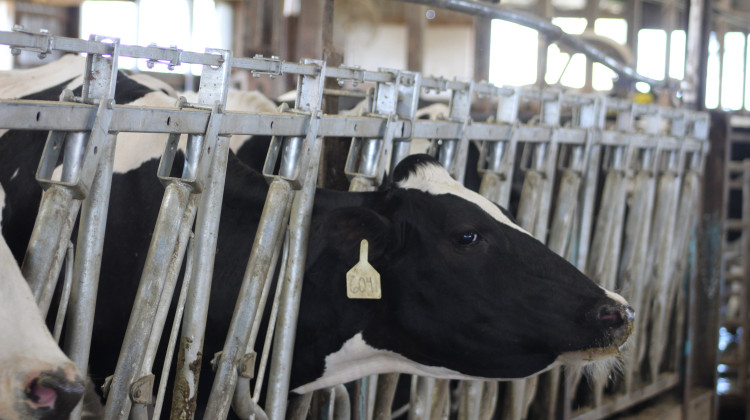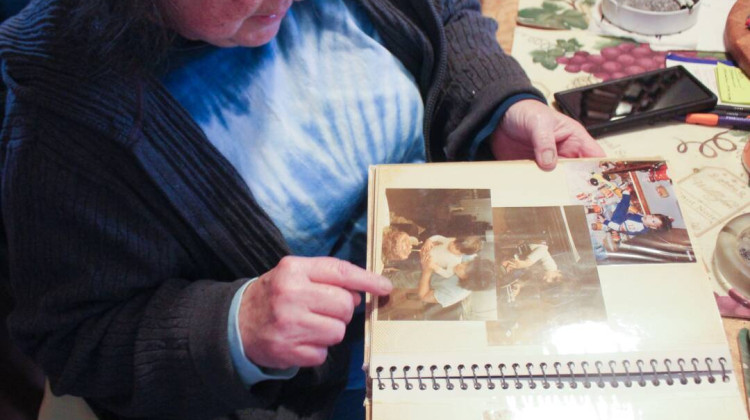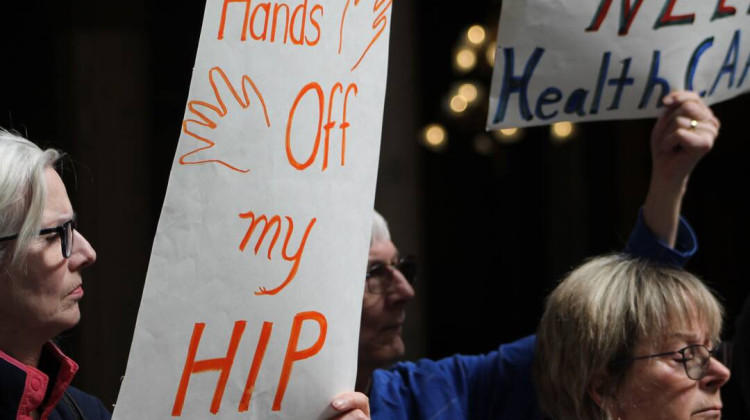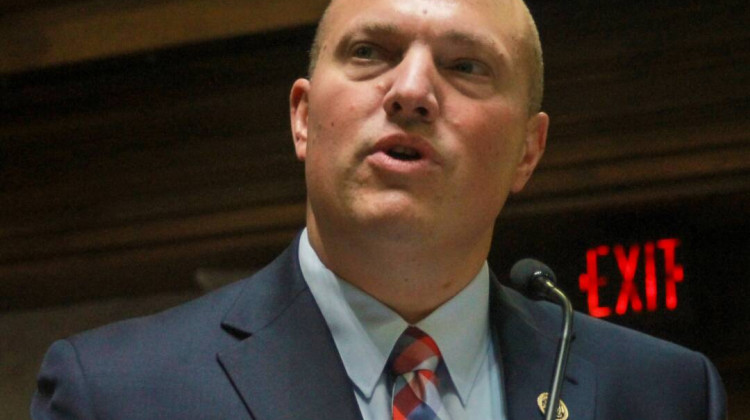
Testing by the U.S. Food and Drug Administration from April found that 20% of retail milk samples showed fragments of the H5N1 virus. But public health experts worry states just aren't doing enough surveillance to capture the real number of infections.
Ben Thorp / WFYIAt Purdue University dairy’s open barn, visitors have to put on blue booties to cover their feet –– a typical measure to keep potential diseases from leaving on a visitor’s shoe.
But what is new is a sign-in sheet at the dairy’s entrance which includes a column titled “date of last contact with cattle.”
The farm has also placed owl scarecrows and noise cannons to scare off birds potentially infected with the bird flu or H5N1 from interacting with the nearly 150 dairy cows there.
“The big unknown is how long this will last and will it die out after this year or will this be back every year? Is this going to be the seasonal flu that we have every year now? I don’t know,” Thomas Cully, manager of Purdue’s dairy unit, said.
Indiana, where Cully’s farm is located, doesn’t have confirmed cases of bird flu infections in cows or humans yet. But the risk inches closer as the virus has already spread in cow herds across nine states. Some experts also worry that the real number of infections in both cows and humans is unknown as testing and monitoring efforts face barriers and lags.
While bird flu has infected different animals –– including mammals –– before, it’s the first time the virus has made its way to dairy cows, which humans have intimate contact with.
The risk of bird flu becoming a human virus remains low, but there are signs that public health experts and the agricultural industry may not be on the same page about the urgency of responding to the virus, potentially hampering efforts to contain it.
Already, this year, the virus has infected three workers in close contact with sick cows. The first two in dairy workers showed up as eye irritation, or conjunctivitis. But the third case in Michigan included respiratory symptoms. Scientists say that increases their concern.
“If we’re going to have a pandemic of H5 in humans it’s unlikely to be a conjunctivitis pandemic, it's going to be respiratory,” said Richard Webby, a virologist at St. Jude’s Children’s Research Hospital in Tennessee.
The CDC Deputy Director Nirav Shah said the presence of the respiratory symptoms in the Michigan worker, which included a cough, “tells us that the exposure risk is higher”.
“Simply put, someone who’s coughing may be more likely to transmit the virus than someone who has an eye infection like conjunctivitis,” Nirav said in a press conference on May 30.
The broader concern, as the bird flu spreads through new animals, is that it gives the virus more opportunities to evolve –– getting one step closer to turning into a human virus.
Local wait-and-see approach worries public health experts
Some experts suspect there are already more cases –– both human and cow –– that aren’t being caught, for a simple reason: Some states are not looking for the virus.
In Indiana, agricultural officials said they won’t start monitoring dairy workers for bird flu until the first cow infection is confirmed in the state.
Denise Derrer Spears, a spokesperson with the Indiana State Board of Animal Health, worries if cow infections are confirmed in the state, it could mean a financial hit.
“It turns into extra limitations or resistance to buy products because it originated in Indiana just because one farm was found here, but we have 698 others,” she said. “It could be an economic disadvantage to producers if we find it in the state.”
When reached for comment, a spokesperson for the Indiana Department of Health said they have a “robust influenza surveillance system” and that IDOH “collaborates with the Indiana Board of Animal Health (BOAH) when H5N1 is detected in animal populations”.
But Spears said there is concern that farmers may not want to self-report cases on their farms.
“We’re trying to communicate with them as much as we can to assure them that we’re going to get through this,” she said.
To that end, federal officials recently announced subsidies for farmers who lose milk due to the bird flu. They’re also offering to reimburse producers for veterinary costs associated with milk sampling and support biosecurity planning and implementation, for up to $1,500 per premise. It’s one of several steps the feds are taking to help track the virus.
But the different incentives and misaligned priorities worry Dr. Michael Osterholm, the director of the Center for Infectious Disease Research and Policy at the University of Minnesota. He said on the one hand, farms don’t want to lose business or be looked at as getting people sick. On the other hand, unchecked, the virus could pose an unprecedented risk to human health.
“We have very different points of view in terms of what is critical right now,” Osterholm said. “So none of these are, in a sense, the wrong perspective to have. But if one day, this virus were to change sufficiently, it could kill lots of people. So, now I have a real concern about what's going on in your farm.”
Michigan takes a proactive approach
Across the country, some 44 people have been tested for H5N1, most are in Michigan. There are also roughly 390 people being monitored for the virus, according to the U.S. Centers for Disease Control and Prevention.
Osterholm said Michigan is seeing more cases not because the state necessarily has more disease, but because they are actively looking for the virus.
“They have really created one of the best models I've seen where [the state agriculture and health departments] are working very closely together,” he said. “That's why we see so many more farms confirmed in Michigan.”
Osterholm believes the key to that kind of monitoring is getting people to come to the table.
Michigan’s Chief Medical Executive, Dr. Natasha Bagdasarian, echoed the same sentiment. She said the time to create trust between health experts and farmers is before an outbreak.
“We learned that during COVID if the trust does not exist, it's really hard to create it during a time of stress,” she said. “And so what we are relying on right now is the goodwill and relationships that exist between our local health departments and the farms in their jurisdictions.”
According to Bagdasarian, Michigan knew early on that infected cows had entered the state, and immediately began monitoring farmworkers connected to those farms. The state also coordinated with local health departments to test anyone with exposure to cows showing influenza symptoms for H5N1.
“In Michigan, we have tested 35 People and we’re leading the country in terms of the number of tests being done,” she said during an interview on May 23. “I think that allowed for this early detection.”
For now, the CDC has asked states to ramp up their influenza surveillance over the summer to keep track of the virus and how it’s behaving.
Side Effects Public Media is a health reporting collaboration based at WFYI in Indianapolis. We partner with NPR stations across the Midwest and surrounding areas — including KBIA and KCUR in Missouri, Iowa Public Radio, Ideastream in Ohio and WFPL in Kentucky.
 DONATE
DONATE






 Support WFYI. We can't do it without you.
Support WFYI. We can't do it without you.